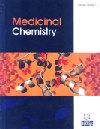A Preclinical Study on 4-Methyl-N-((4-(trifluoromethoxy)phenyl) carbamoyl)-benzenesulfonamide as a Potent Chemotherapeutic Agent against Liver and Pancreatic Carcinogenesis in Rats: Immunohistochemical and Histopathological Studies
IF 1.9
4区 医学
Q3 CHEMISTRY, MEDICINAL
引用次数: 0
Abstract
Background: Alternative and complementary applications of newly synthesized chemicals have enhanced the prospect of finding curative treatments for liver hepatocarcinogenesis and pancreatic cancer. Methods: The current study investigated the curative effect of the newly synthesized drug 4- methyl-N-((4-(trifluoromethoxy) phenyl) carbamoyl) benzenesulfonamide (3) against diethyl nitrosamine (DEN) (50 mg/kg) and carbon tetrachloride (CCl4) (2 mg/kg)-induced hepatocellular carcinoma (HCC) and pancreatic cancer in male rats using doxorubicin as a reference drug. Results: The findings demonstrated that the DEN/CCl4 treatment produced oxidative stress, as evidenced by an increase in MDA and a reduction in GSH levels. A temporary decline in antioxidant and total antioxidant capacity (TAC) was detected. An increase in the levels of TNF-α and other inflammatory markers, interleukin-6 (IL-6) and B-cell lymphoma 2 (Bcl-2), was found. Our findings showed that the liver and pancreas had significantly higher levels of hepatocellular carcinoma biomarkers, namely α-fetoprotein and α-L-Fucosidase (α-FU). Changes in the biomarkers of hepatic function were also seen, with elevated levels of γ-glutamyltransferase (GGT), alkaline phosphatase (ALP), and transaminases (AST, ALT). Our findings were supported by immunohistochemical and pathological examinations, which revealed considerable improvement in liver and pancreatic tissues after treatment with medication 3 when compared to normal healthy rats. Conclusion: To summarize, the new synthetic medication 3 could be an effective chemotherapeutic method for treating DEN and CCl4-induced HCC and pancreatic cancer.4-甲基-N-((4-(三氟甲氧基)苯基)氨基甲酰基)-苯磺酰胺作为抑制大鼠肝癌和胰腺癌发生的强效化疗药物的临床前研究:免疫组织化学和组织病理学研究
背景:新合成化学物质的替代和互补应用为找到治疗肝癌和胰腺癌的方法提供了更广阔的前景。研究方法本研究以多柔比星为参照药物,考察了新合成药物 4-甲基-N-((4-(三氟甲氧基)苯基)氨基甲酰基)苯磺酰胺(3)对亚硝胺二乙酯(DEN)(50 mg/kg)和四氯化碳(CCl4)(2 mg/kg)诱导的雄性大鼠肝细胞癌(HCC)和胰腺癌的治疗效果。结果研究结果表明,DEN/CCl4 处理会产生氧化应激,表现为 MDA 增加和 GSH 水平降低。检测到抗氧化剂和总抗氧化能力(TAC)暂时下降。TNF-α和其他炎症标志物(白细胞介素-6(IL-6)和B细胞淋巴瘤2(Bcl-2))的水平也有所增加。我们的研究结果表明,肝脏和胰腺的肝细胞癌生物标志物水平明显较高,即α-胎儿蛋白和α-L-岩藻糖苷酶(α-FU)。肝功能生物标志物也发生了变化,γ-谷氨酰转移酶(GGT)、碱性磷酸酶(ALP)和转氨酶(AST、ALT)水平升高。免疫组化和病理检查证实了我们的发现,与正常健康大鼠相比,药物 3 治疗后肝脏和胰腺组织得到了显著改善。结论综上所述,新合成药物 3 是治疗 DEN 和 CCl4 诱导的 HCC 和胰腺癌的有效化疗方法。
本文章由计算机程序翻译,如有差异,请以英文原文为准。
求助全文
约1分钟内获得全文
求助全文
来源期刊

Medicinal Chemistry
医学-医药化学
CiteScore
4.30
自引率
4.30%
发文量
109
审稿时长
12 months
期刊介绍:
Aims & Scope
Medicinal Chemistry a peer-reviewed journal, aims to cover all the latest outstanding developments in medicinal chemistry and rational drug design. The journal publishes original research, mini-review articles and guest edited thematic issues covering recent research and developments in the field. Articles are published rapidly by taking full advantage of Internet technology for both the submission and peer review of manuscripts. Medicinal Chemistry is an essential journal for all involved in drug design and discovery.
 求助内容:
求助内容: 应助结果提醒方式:
应助结果提醒方式:


